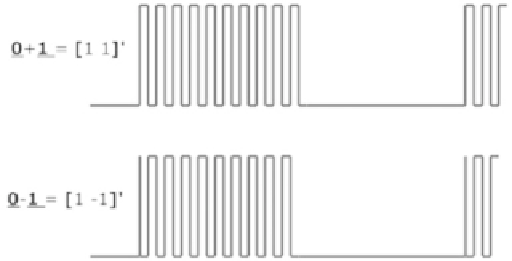Information Technology Reference
In-Depth Information
Fig. 10.4
Phase shift in the “1”
The h-Transform
[1 1]
0
from
The problem addressed now is to distinguish a simulated qubit in state
η
1]
0
. It is not permitted to place an oscilloscope probe directly to a
multivibrator because recursive neurons are assumed to be too small, delicate, and
easily upset. Rather it is desired to perform some sort of transformation on the
qubit such that after sampling occurs, phase will be indicated as an output of the
sampling.
By modifying delays, it is possible to manipulate the frequency and the phase of
the multivibrators. This in turn can be made to provide useful information after
sampling, which results in a simple true or false answer about the hidden states of
the multivibrator vectors. Manipulating frequency and phase is an operation on the
probability space of a simulated qubit, that is, a rotation on the sphere of a previous
chapter. An example is given by the h-transform, which is analogous to the
Hadamard transform of mathematics.
Let
a
one in state
η
[1
[1 1]
0
be a point on the sphere. Based on this, define [pq]
0
where
¼ η
[b
1
b
2
]
0
:
p
¼
1; q
¼
1. Next consider a transformation that provides
b
¼
2
2
q
b
1
¼ð
1
η
Þ
p
þ η
¼
1
:
(10.3)
2
2
q
2
b
2
¼ð
1
η
Þ
p
η
¼
1
2
η
¼
1
1
¼
0
:
(10.4)
2
[1 1]
0
transforms to [1 0]
0
internally, which after
sampling is
0
or false, determined with certainty with one sampling (or measure-
ment). So it is possible to know that the original vector is η [1 1]
0
without having to
probe and perhaps disturb the multivibrator. Finally the h-transform is reversible in
case it is desired to return the vector to its original state.
For
Note that
η
¼
0.5. So
η
1]
0
, similarly define [pq]
0
where p
η
[1
¼
1; q
¼
1. Then consider a
[b
1
b
2
]
0
:
transformation that provides
b
¼

Search WWH ::

Custom Search